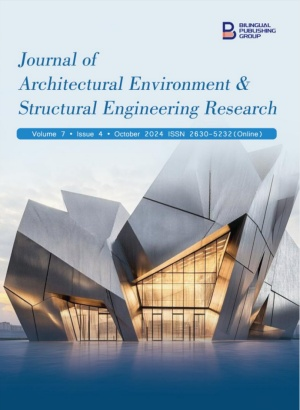-
366
-
207
-
192
-
183
-
181
Housing Stock Optimisations
DOI:
https://doi.org/10.30564/jaeser.v8i3.10938Abstract
In Japan, aging housing complexes are considered a key component of the national housing stock. However, renovation projects often prioritize initial costs over long-term energy performance. Although retrofitting insulation effectively reduces energy consumption, budget constraints and competing priorities, such as architectural improvements and airtightness measures, limit its adoption. Few academic studies have quantified the economic and energy-saving impacts of retrofitting existing apartment buildings. This study uses TRNSYS simulations to evaluate retrofitting scenarios for a typical aging apartment complex. The analysis focuses on lifecycle costs and annual heating and cooling loads. Results indicate that ceiling insulation yields the largest reduction in heat load. The numerical data generated by this research offer practical guidelines for design practitioners evaluating retrofit options. A cost breakdown based on material and labor estimates is provided to demonstrate the trade-off between investment and energy savings. Sensitivity analyses assess the robustness of the findings when insulation thickness and energy prices vary. This study provides a database of thermal performance metrics for existing buildings to support decision-making in renovation projects. The implications include optimized retrofit strategies that balance initial costs and energy efficiency, thereby promoting the sustainable management of aging housing stock. The results serve as a reference for architects, engineers, and policymakers involved in building energy retrofits. By quantifying the relationship between insulation measures and thermal load, the database helps planners mitigate risks such as indoor thermal discomfort and cold-related health hazards in older residences.
Keywords:
Energy; Heat Load; SimulationReferences
[1] Iso, K., Costa, M., Jung, J., et al., 2015. Rental customization based on landlord's investment – Skeleton infill rental housing: Challenges and opportunities in Japan (Part 1). Summaries of Technical Papers of Annual Meeting, Architectural Institute of Japan, Architectural Design Presentation. pp. 999–1000 (In Japanese).
[2] Agency for Natural Resources and Energy, 2022. ZEH Definition (Housing). Available from: https://www.enecho.meti.go.jp/category/saving_and_new/saving/assets/pdf/general/housing/zeh_definition_kodate.pdf (cited 17 June 2022).
[3] Society of Hyper-Enhanced Insulation and Advanced Technology for the Next 20 Years, 2022. HEAT20. Available from: http://www.heat20.jp/ (cited 17 June 2022).
[4] Ministry of Land, Infrastructure, Transport and Tourism, 2022. Policy Bureau. Available from: https://www.mlit.go.jp/jutakukentiku/jutakukentiku_house_tk4_000103.html (cited 17 June 2022).
[5] Rosas-Flores, J.A., Rosas-Flores, D., 2020. Potential energy savings and mitigation of emissions by insulation for residential buildings in Mexico. Energy and Buildings. 209, 109698. DOI: https://doi.org/10.1016/j.enbuild.2019.109698
[6] Mizuta, K., Ikaga, T., Murakami, S., 2007. Estimation of renovation effect by injecting polyurethane foam into walls and windows up to 2020 in Japan. Transactions of AIJ. 72(614), 99–106 (In Japanese). DOI: https://doi.org/10.3130/aije.72.99_2
[7] Doi, S., Takada, M., Chikamoto, T., et al., 2016. Partial insulation remodeling method using insulated sliding doors in an existing apartment building. Transactions of AIJ. 81(720), 249–258 (In Japanese). DOI: https://doi.org/10.3130/aija.81.249
[8] Yoshiura, A., Nakazono, M., Koganei, M., et al., 2013. Simulation of environmental performance and heating load of a traditional timber house by heat insulation and floor heating. Transactions of AIJ. 78(686), 333–340 (In Japanese). DOI: https://doi.org/10.3130/aije.78.333
[9] Hirai, K., Yi, S., Tsutsumi, H., et al., 2011. Repair methods for existing school facilities to extend using time. Transactions of AIJ. 76(664), 1163–1170 (In Japanese). DOI: https://doi.org/10.3130/aija.76.1163
[10] Hirose, T., Takaguchi, H., 2011. Investigation of insulation efficiency of existing apartments and energy saving of insulation renovation. Transactions of AIJ. 76(664), 581–586 (In Japanese). DOI: https://doi.org/10.3130/aije.76.581
[11] TRNSYS, 2022. What is TRNSYS? TRNSYS – Transient System Simulation Tool. Available from: http://www.trnsys.com/ (cited 17 June 2022).
[12] Economic Research Association, 2022. Pocket Estimation Reference Book – Reform Edition (In Japanese).
Downloads
How to Cite
Issue
Article Type
License
Copyright © 2025 Tatsuhiro Yamamoto

This is an open access article under the Creative Commons Attribution-NonCommercial 4.0 International (CC BY-NC 4.0) License.




 Tatsuhiro Yamamoto
Tatsuhiro Yamamoto






